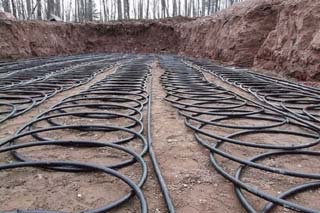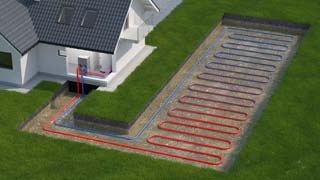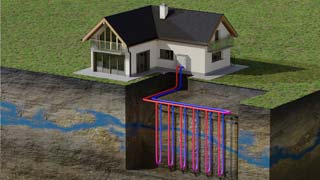
Geothermal Heating
How Deep is Geothermal Heating
![]() Geothermal Heating, also known as “ground source heating”, works by taking advantage of the constant temperature found below the Earth’s surface. While the ambient air temperatures around us will fluctuate significantly throughout the year, due to seasonal variations, the ground temperature beneath our feet remains relatively stable at about 50-to-70oF (10-to-21oC) at certain depths all year around.
Geothermal Heating, also known as “ground source heating”, works by taking advantage of the constant temperature found below the Earth’s surface. While the ambient air temperatures around us will fluctuate significantly throughout the year, due to seasonal variations, the ground temperature beneath our feet remains relatively stable at about 50-to-70oF (10-to-21oC) at certain depths all year around.
Our Earth’s inner core consists mainly of a large solid metallic sphere within a larger liquid outer core of molten iron. The radioactive decay of uranium and other elements within the core is the main reason for its high temperature of more than 7000 degrees Fahrenheit, (+4000oC). This enormous amount of heat slowly migrates through the various layers (mantle) of the Earth reducing in temperature until it reaches the Earth’s surface, called the crust where it helps to warm the soil and protect our planet.
Then without this never ending source of thermal heat rising up from the cores interior, the Earth’s surface would probably be cold and frozen, with only the sun’s solar radiation that is absorbed by the surface and its atmosphere to keep us warm. Therefore in theory, free heat energy can be extracted from the Earth’s crust, no matter how cold the ambient temperature above ground.

A geothermal heating system can be considered as a “renewable energy system” and sustainable, since the heat energy that we can extract from within the ground being very small compared to the vast heat content of the Earth’s central core.
Compared to burning fossil fuel sources of energy such as propane, oil, coal, or natural gas, it is a non-polluting and environmentally friendly free energy source which has minimal land usage or freshwater requirements. Also, the electricity used to power geothermal heat pumps and system from non-renewable fuel sources being of a small amount.
Geothermal is very well suited for both modern home heating and cooling systems, with geothermal heating becoming a very popular and cost-effective alternative to traditional oil or gas burning home heating systems. Unfortunately the geothermal technology required to extract the heat from the ground is not cheap, but it is extremely clean and reliable.
Homeowners are generally unaware that just about any location beneath their homes can be used as a source of geothermal heat during the winter months if they dig deep enough. Temperatures nearer to the Earth’s surface are more influenced by the effects of the Sun’s and its solar radiation as well as the ambient air temperature rather than the heat coming from the Earth’s central core.
Geothermal Heat Pumps
The main component of a geothermal heating system is the heat pump, also referred to as the Ground Source Heat Pump. It gets its name because it transfers or moves heat from the ground to a closed space rather than generating heat from burning carbon-based fossil fuels. Thus it uses the Earth as a giant heat source (in the winter) or a heat sink (in the summer).
Basically, the Ground-source Heat Pump (GSHP) is a thermodynamic heating/refrigerating unit which can use the ground, groundwater, or surface water as a constant heat source. Plastic polyethylene piping used as ground loops which have direct thermal contact with the ground are connected directly to a ground source heat pump. So how deep is geothermal heating?
How Deep for Geothermal Heating
When it comes to geothermal heating, depth matters, unless of course you live in a tectonically or volcanically active area. For depth requirements, there are two main geothermal installation approaches: Horizontal Ground Loops, and Vertical Ground Loops.
Ground loops are the pipes used to carry the heat within a liquid to and from the heat pump. They generally consist of a single open or closed loop in direct thermal contact with the soil placed horizontally, if adequate space is available, or vertically, if land space is limited. The one suitable for your location will determine how deep geothermal heating coils will go beneath the surface.
Horizontal Ground Loops

Firstly, whichever ground loop installation is suitable for your location, water filled ground loops are almost always constructed from black high density polyethylene pipe (poly-pipe) due mainly to its durability and corrosion-resistance to deterioration from water or chemicals within the ground. Poly-pipe is also flexible and can withstand sub-zero temperatures without damage with various pipe sizes ranging from 3/4″ to 1/1/2″.
Horizontal ground loops are the most common for residential installations, and can be divided into three main subgroups: single pipe, multiple pipes, and coiled pipe. Closed-loop piping systems buried deep underground use a liquid (water or a water/ethanol or water/glycol (antifreeze) solution) as their working fluid circulated through them. A ground-source heat pump is connected directly to the pipework allowing the heat underground to be absorbed during cold times.
Horizontal ground loops are typically laid into long narrow trenches buried from 6 to 10 feet (2 to 3 meters) deep below the surface and as such, horizontal loops require the greatest amount of ground space. But they are less expensive to install since you just need to dig a suitable trench.
Multiple pipes of two or four individual loops in a “Slinky configuration” (like the child’s toy) can be placed in the same trench to form a flat overlapping pattern, but at a much greater depth to reduce the amount of required ground space. Different degrees of overlapping of the loops (called pitch) can be created to increase efficiency.
However for multiple Slinky type pipe configurations, the concept of “depth matters” is more important as you may think you only need a much smaller trench or ground footprint to extract the heat. But the possibility of thermal depletion once buried is much higher for multiple ground loops within the same trench. Also, there is more tubing required per unit length of trench as well for the flow and return manifold connections. This increases the overall cost compared to a single ground loop for the same installation.
Vertical Ground Loops

As their name suggests, vertical ground loops consist of a series of long, narrow boreholes drilled vertically into the ground. For optimal performance, the installation depth should reach a thermal zone where the ground temperature remains constantly high throughout the year. This typically ranges in depth from about 100 to 400 feet deep (30 to 120 meters).
Within each borehole drilled about 20 feet apart, a U-shaped (flow and return) loop of poly-pipe is inserted which is filled with water or a conductive fluid (a water/antifreeze solution). The deep boreholes are backfilled with thermal grout to ensure proper heat transfer between the ground and the long U-shaped pipe.
Vertical loops are especially useful in areas where the available ground space is limited, or where the geology of the area does not allow for larger horizontal ground loops. The advantage of vertical ground loops is that their deeper contact with the ground allows access to more constant underground temperatures that vary little in both temperature and thermal properties the deeper you go.
Thus, any seasonal variations in ground temperatures decrease as depth increases, unlike the shallower conditions of horizontal loops. This in-turn leads to a more efficient heating (and cooling) system all year-round.
Also, since the loops go straight down, there is minimal disturbance to the surrounding landscape after installation. However, vertical ground loops can be more expensive to install compared to excavating horizontal trenches because the drilling of deep vertical boreholes requires specialised equipment. Clearly, the local geology and ground composition (rocky vs. sandy soils, groundwater levels, etc.) will play an important role in determining the ease and cost of any installation, as well as the buildings heating/cooling requirements.
The main disadvantages of vertical ground loops are that unlike the different variations in horizontal ground-loop systems, vertical loop systems have basically one configuration. When multiple boreholes are required, it’s important that each borehole loop are of the same length to ensure that the flow rate, and therefore the heat transfer, is the same for each borehole.
Pond or Lake Geothermal Heating
If either horizontal or vertically installed ground loops are not possible, it could be possible to use a nearby body of water such as a pond or lake which meets the heating requirements to heat a home. Geothermal heat pumps can use coils placed within water instead of underground.
The pipework is commonly run underground from the home or building to the body of water and coiled into slinky type circles within it. Using ponds, lakes, geothermal wells or other such large bodies of water is a cheaper alternative to ground loops. However, in cold regions and climates the coils need to be placed at least 8 or 9 feet (3m) under the waters surface to prevent freezing.
Tutorial Summary
In summary. We have seen here that for residential geothermal heating systems we can use the vast temperatures available under the ground as a permanent heat source for the effective heating and/or cooling of our homes. Since these temperatures do not change much no matter how warm or cold it gets outside.
How deep for geothermal heating depends on the type of system being installed. Clearly, you need to bury any closed-loop coils deep enough so that they are unaffected by any frost or snowy conditions during the winter months. The geothermal heating ground loops can be placed horizontally, or vertically to save on space.
As discussed, a geothermal heating ground loop is nothing more than a long plastic pipe buried in the ground to a depth where the temperatures stay consistent all year round. It is used basically as a heat exchanger, allowing the geothermal heat pump(s) connected to it to use the Earth as a constant heat source (or heat sink).
Then the depth of geothermal heating loops or coils can be anywhere from 6 to 10 feet (2 to 3 meters) deep for horizontal loops, or they can extend several hundred feet deep for vertical loops, which can make them more effective. The disadvantage of horizontal ground loops is that they need to be installed over a wide area of ground.
While the depth of any ground loop required for the heating of a house is important, is generally not proportionate to the amount of heat it can produce. Since the number of individual ground or coil loops is. The ground loop length and pipework size is based on the geothermal heat pump (GHP) size, as well as the heat conductivity of the local soil (what its made of), and the surrounding ambient temperatures throughout the year. So the larger a home’s heating and cooling requirements, the larger the geothermal heat pump required, and therefore the larger the ground loop or number of coils needed per ton of heating.
Geothermal energy is good for the environment, and installing a geothermal heating system to replace an old fossil fuel burning system will definitely reduce your carbon emissions. The cost-effectiveness of geothermal heating and cooling systems will continue to improve as geothermal heat pumps and their technology is improve while fossil fuel prices rise. Then Geothermal energy has a very promising and continuous future in heating our homes and buildings using green and sustainable heat energy.
To learn more about how geothermal heating takes advantage of the constant temperatures of 50-to-70oF (10-to-21oC) to efficiently heat our homes in the winter and cool them in the summer. Or to understand how deep for geothermal heating ground loops need to be to be effective. Then find the ideal Geothermal Heating book today direct from Amazon and understand how you can use this cost-effective, and energy-efficient heating and cooling solutions in your home.











Please Speak up!
We hope this Geothermal Heating Tutorial was useful and informative for you. Are you ready to share your thoughts
and experience with us and many others. Your comments are always welcome, just post them in the section below.
P.S. Don't forget to like, rate, and share this Alternative Energy Tutorials post. Thank you for using our website.